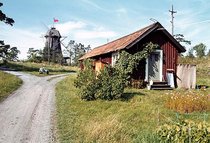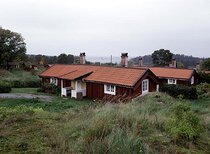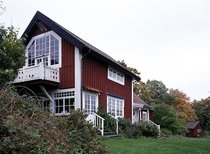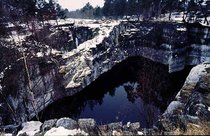Utö
Iron ore has been mined at Utö in the Haninge archipelago for centuries. The island has been marked by this industry, which reached its zenith in the middle of the 1850s.
What may be the oldest iron mines in Sweden lie at northern Utö: they were opened in the early mediaeval period and in use until the end of the 19th century. Open-cast mines and the massive heaps of waste rock set their mark on the landscape. It is possible that the extraction of iron ore at Utö can be demonstrated as early as the 12th century. Support for this opinion comes from the finding of a mineral in the mediaeval cultural treasures of Visby that is found only on Utö. During the period when Sweden was a major power, in the 17th century, mining on Utö was carried out by the owner of Årsta Castle in Österhaninge, Clas Bielkenstierna. Much of the ore was sent to Åkers styckebruk during this period, for the manufacture of cannon and cannon balls.
Wood consumption
Until the end of the 18th century, ore was extracted by heating the rock by large fires and then rapidly cooling it with water. The fractured rock that this gave was subsequently worked with hammer and stake. Huge amounts of wood were consumed and it was necessary to buy large quantities. Using explosives, however, would have been much more expensive.
Water power was not available on Utö, so horses and oxen were used to power the winches, and wind-power for the pumps. Operation of the mine had to be suspended when deliveries of fodder were interrupted.
The Russians sacked the archipelago in 1719 and all buildings at the Utö mines were burnt down. Further, the Russians filled the mine shafts with waste rock, in order to make restarting the mines more difficult.
Increased operations
With the exception of the Långgruvan mine, however, which even today remains filled of rock, all of the old shafts were reopened. This was followed by a period in which operations continuously expanded.
Agriculture dominated at the southern part of the island, and the population gradually increased here. The population of mine workers, however, followed closely the economic climate. At the beginning of the 19th century, the newly formed mining company purchased the complete island, and this led to major changes. All farms and crofts were absorbed into large-scale agriculture.
Steam machines were installed during the 19th century to pump water from the mines, and a railway was built to carry ore to the harbour. Activity peaked in the 1840s, when production at the Utö mines was just over 16,000 tonnes of ore per year.
Company failure
It was during this period of prosperity that Utö Church was built. It was designed by JF Åbom and financed to a large degree by the mining company. Measured by the standards of the archipelago, the church at Utö is extremely large.
The period of prosperity, however, proved to be brief. Following a number of mining cave-ins and faced with stiff competition from mines in Bergslagen, the company was forced to end production in 1879.
However, the regular traffic of steamers meant that summer guests started to appear, and those living in the island saw new opportunities. The mine office was converted to a restaurant, and a leisure building for guests was built nearby.
A military range
During the Second World War, the Swedish parliament decided to use most of Utö as a military shooting range, and this meant the end of its period as summer spa.
The Archipelago Foundation took over the northern part of the island in 1974 with the old mine area, and the foundation invested heavily in the site. Since then, visitor numbers to Utö have increased markedly. The old miners’ homes still lie along Lurgatan, while a windmill from the 18th century is a well-known landmark for sailors. It has become the symbol of Utö.
Utö Mining Museum has a fine collection of ore and rock from the island, with photographs and descriptions showing how ore was once handled.
Links
The Archipelago Foundation (Skärgårdsstiftelsen)
Utö turisbyrå
Regular boat connections from Dalarö and Årsta havsbad.




